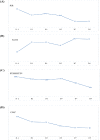Usefulness of convalescent plasma transfusion for the treatment of severely ill COVID-19 patients in Pakistan
- PMID: 34579646
- PMCID: PMC8475331
- DOI: 10.1186/s12879-021-06451-7
Usefulness of convalescent plasma transfusion for the treatment of severely ill COVID-19 patients in Pakistan
Abstract
Background: Convalescent plasma(CP) was utilized as potential therapy during COVID-19 pandemic in Pakistan. The study aimed at appraisal of CP transfusion safety and usefulness in COVID pneumonia.
Methods: Single arm, MEURI study design of non-randomized open label trial was conducted in five centers. Patients werecategorized as moderately severe, severe, and critical. The primary endpoint was a) improvement in clinical status and change in category of disease severity; secondary endpoint was b) CP ability to halt disease progression to invasive ventilation. CP transfused to hospitalized patients. Statistical tests including median (interquartile ranges), Mann-Whitney U test, Fisher's exact test using SPSS ver. 23, ANOVA and Chi-square test were applied for the analysis of results parameters before and after CP treatment. SOFA score was applied for multiorgan failure in severe and critical cases.
Results: A total of 50 adult patients; median age 58.5 years (range: 29-92 years) received CP with infusion titers; median 1:320 U/mL (Interquartile range 1:80-1:320) between April 4 to May 5, 2020. The median time from onset of symptoms to enrollment in trial was 3 to 7 days with shortness of breath and lung infiltration as severity criterion. In 35 (70%) recipients, oxygen saturation improved from 80 to 95% within 72h, with resolution of lung infiltrates. Primary endpoint was achieved in 44 (88%) recipients whereas secondary endpoint was achieved in 42 (84%). No patient experienced severe adverse events. A high SOFA score (> 7) correlated with deaths in severe and critical patients. Eight (16%) patients expired due to comorbidities; cardiac arrest in 2 (4%), multiorgan failure secondary to cytokine storm in 5 (10%) and ventilator associated complications in 1 (2%).
Conclusion: CP transfusion can be used as a safe and useful treatment in moderately severe and severe patients.
Trial registration: The trial registration number is NCT04352751 ( https://www.irct.ir/search/result?query=IRCT20200414047072N1 ). Trial Registration date is 28th April 2020.
Keywords: COVID-19; Convalescent CP recipient; Convalescent plasma (CP); SARS CoV2 infection; SOFA score.
© 2021. The Author(s).
Conflict of interest statement
There are no conflict of interest to disclose.
Figures




References
-
- Siddell SG. The coronaviridae. Springer. 1995:1–10. https://www.springer.com/gp/book/9780306449727.
-
- Lu R, Zhao X, Li J, Niu P, Yang B, Wu H, Wang W, Song H, Huang B, Zhu N, Bi Y, Ma X, Zhan F, Wang L, Hu T, Zhou H, Hu Z, Zhou W, Zhao L, Chen J, Meng Y, Wang J, Lin Y, Yuan J, Xie Z, Ma J, Liu WJ, Wang D, Xu W, Holmes EC, Gao GF, Wu G, Chen W, Shi W, Tan W. Genomic characterisation and epidemiology of 2019 novel coronavirus: implications for virus origins and receptor binding. Lancet. 2020;395(10224):565–574. doi: 10.1016/S0140-6736(20)30251-8. - DOI - PMC - PubMed
Publication types
MeSH terms
Associated data
Grants and funding
LinkOut - more resources
Full Text Sources
Medical
Miscellaneous

